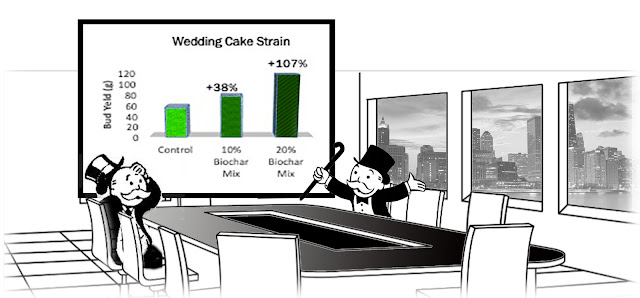Clash of the Negative Emissions Titans: Cannabis, Meet Biochar
"These signs and portents point to a coming Anthropocene that will not be your daddy’s World War II."
If you are a billionaire captain of industry, what are you willing to spend to assure some legacy — any legacy — remains of the contributions you’ve made, after you are gone? Not many would say none. It is a human trait to want to be remembered.
When we look down the long, dark tunnel of our future towards the prospect of leaving behind near-term human extinction — possibly the extinction of life on Earth — it kind of puts a crimp in that kind of thinking.
If you are in that category, how now do you spend a billion dollars to be remembered; to have anyone even around to remember anything?
This past week a few hundred researchers, engineers, entrepreneurs, and climate activists huddled together in Ft. Collins, Colorado, which bills itself the “Napa Valley of Beer,” at the Biochar and Bioenergy Conference put on by the US Biochar Initiative.
The first speaker, Erica Belmont from the University of Wyoming, was a co-author of the recent study by the National Academies of Science, Engineering and Medicine (NASEM), Negative Emissions Technologies and Reliable Sequestration: A Research Agenda. She spoke about the various pathways for getting to net zero and then negative emissions (drawdown) by 2100.
 |
| https://www.chelseagreen.com/product/burn/ |
 |
| UNEP 2017, The Emissions Gap Report |
Shermans and bullets, overnight.
This time we are talking about trillions and there will be no country or industry left untransformed. The heat waves now crossing Europe on one side of the world and Alaska on the other should focus attention the way California wildfires were a wake-up call for climate deniers in John Birch country. These signs and portents point to a coming Anthropocene that will not be your daddy’s World War II.
Once you get religion about it, what next? The tendency is towards action; to throw money around wastefully at first, but then to gradually distill down solutions that work. You have to be nimble and responsive because this is a fluid theater of war and stuff happens fast.
But don’t worry. Sit back and roll a fatty (assuming you live in a full-legal state like Colorado). Hemp might just save us all.
 |
Slide Deck courtesy of Wilson Hago and VGRID via USBI
|
Kathleen and I toured a production site owned by Biochar Now just outside Fort Collins and saw what Hago was talking about. Using technology no more complicated than could be made in the early 19th Century, Biochar Now was producing hundreds of tons of biochar for everything from cleaning algae blooms off lakes and ponds to carbon filament for 3D printers. They have $10 million in orders from hemp producers who like theirs blended with bokashi.
So, Mr. Captain of Industry, put that in your pipe and smoke it. Gaze out at the horizon and think of all the good places you should invest.
____________
You encourage me to do more and then tell you about it. Help me get my blog posted every week. All Patreon donations and Blogger subscriptions are needed and welcomed. Those are how we make this happen. PowerUp! donors on Patreon get an autographed book off each first press run. Please help if you can.










Comments